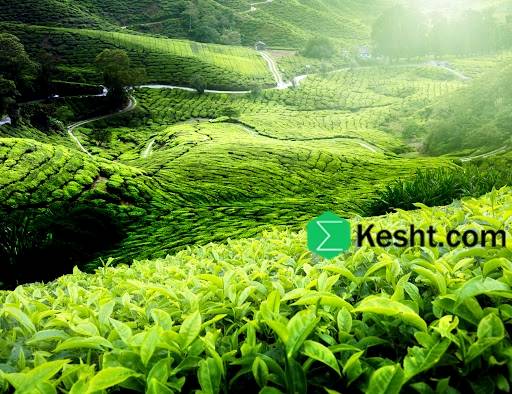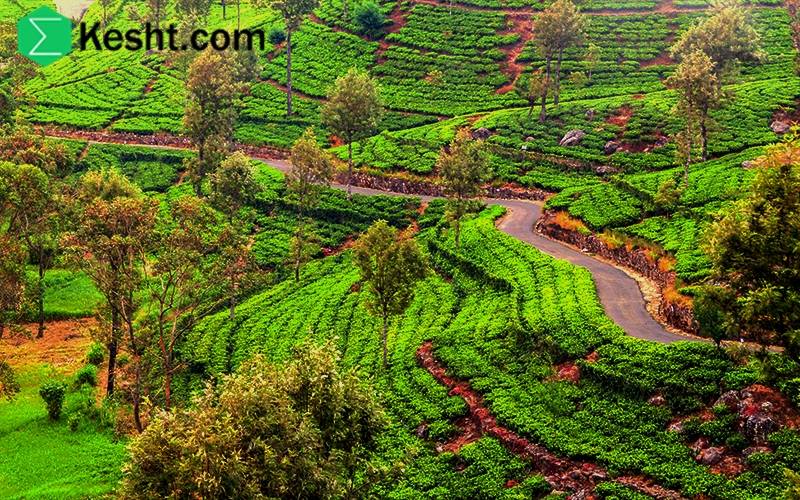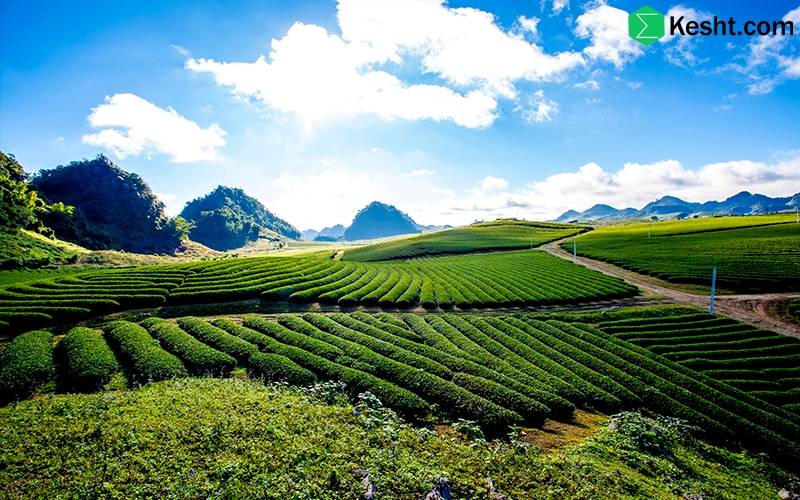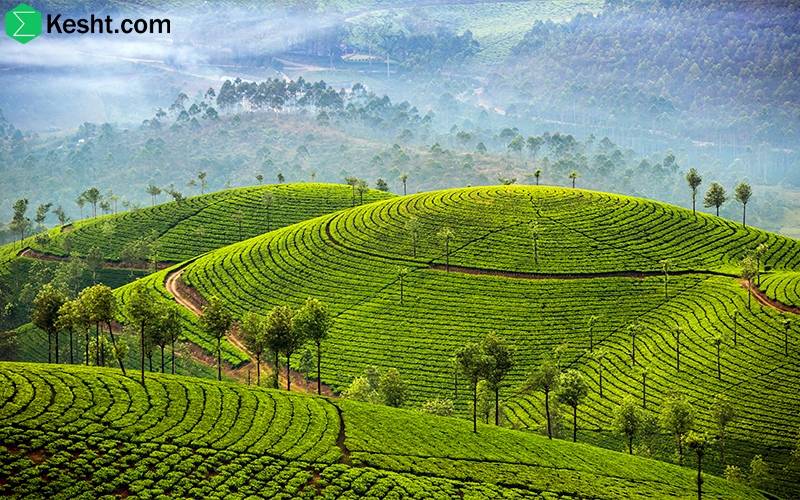# Tea Exports (Part One)
Before diving into the topic of tea exports, let's read a brief introduction about this popular product to better understand the global interest in this exquisite beverage. Join us:
Tea is a drink made by steeping the leaves of the tea plant (Camellia sinensis). This beverage not only enjoys global popularity but also holds a special place in various cultures and traditions.
Tea can act as a soothing wizard; when you have a cup of hot tea in your hands, it brings a sense of calm and comfort. Its aroma and flavor can evoke special memories and create delightful moments. You surely remember a specific setting, perhaps with gentle rain and that warm cup of tea in your hands—this beautiful scene is etched in your mind forever. You are not alone; this is the magic of tea.
In the world of tea, there are various types: green tea with its mild flavor and antioxidant properties, black tea with its strong aroma and rich taste, and herbal tea, known for its natural medicinal qualities. Each type of tea has a story and can convey diverse sensations with its unique aromas and flavors. Moreover, the tea-drinking ceremony in many cultures is an art and a ritual. From traditional tea houses in Iran to Japanese tea ceremonies, each represents a unique philosophy and beauty.
Tea is not just a beverage; it is a bridge between people, cultures, and histories. The tea ceremony in different cultures holds particular social and cultural significance.
### Examples of Tea Ceremonies
1. **Tea Ceremony in Iran**
In Iran, the tea ceremony is often intertwined with hospitality. Tea is served as an important beverage during gatherings and family events. It is usually accompanied by sugar, dates, or local sweets. Drinking tea alone provides an opportunity for conversation and building social connections.
2. **Japanese Tea Ceremony**
The Japanese tea ceremony, or “Chanoyu,” is a profound art and philosophy centered on tranquility, respect, and beauty. In this ceremony, green tea (matcha) is prepared and served in a special manner. The ceremony involves precise steps and beautiful designs, typically held in a calm and traditional setting.
3. **Tea Ceremony in China**
In China, the tea ceremony is recognized as an ancient art. Various types of tea are prepared with great care and attention. Tea drinking in China is not only a physical act but also a spiritual and social experience. Sometimes, this ceremony includes storytelling and music.
4. **Tea Ceremony in England**
In England, tea is especially served in the afternoon as “afternoon tea.” This ceremony includes black tea, small sandwiches, cakes, and biscuits. This tradition dates back to the 19th century and is known as a way to relax and converse during the day.
5. **Tea Ceremony in Thailand**
In Thailand, the tea ceremony is based more on sweet tea and iced tea. These beverages are typically combined with milk and sugar and are served as popular drinks in streets and markets. The tea ceremony here is generally simpler and more informal, considered a daily habit.
6. **Tea Ceremony in Korea**
In Korea, the tea ceremony is known as “Dado.” This ceremony involves the careful preparation and serving of green tea with attention to detail. Here, the philosophy of tranquility and beauty is central, usually conducted in a serene environment.
7. **Tea Ceremony in Mongolia**
In Mongolia, sweet tea with salt and butter is served as a main beverage. This tea, known as “Mongolian tea,” is typically consumed at gatherings and traditional ceremonies, symbolizing hospitality.
8. **Tea Ceremony in India**
In India, “masala chai” is recognized as a popular beverage. The tea ceremony in India is usually informal and familial, involving the brewing of tea with various spices like cinnamon and ginger. Tea has become a daily beverage among the people.
9. **Tea Ceremony in Tibet**
In Tibet, salty tea (yak tea) is very popular. This tea is usually prepared with yak butter and salt and is used as a sign of hospitality and local culture.
10. **Tea Ceremony in South Africa**
In South Africa, “rooibos” tea is a well-known local beverage. The tea ceremony here involves serving rooibos tea with milk or honey, typically held in friendly and family gatherings.
### Tea Ceremonies in Different Cultures
Tea ceremonies in various cultures are recognized as symbols of hospitality, social connections, and art. Each culture has its unique characteristics in tea ceremonies, contributing to cultural richness and diversity. Tea ceremonies are seen not only as a beverage practice but also as an expression of art, respect, and human connections. Each of these ceremonies has its special features and enriches the cultural fabric of societies.
Now that you are familiar with the different cultures and the use and consumption of tea in these countries, let’s move on to the main topic of the article: tea exports.
### Examining Opportunities for Tea Export for Traders
Tea export can be a profitable opportunity for traders, especially considering the growing demand in global markets. Here are some key opportunities and points to consider:
1. **Growing Demand**
- **New Markets**: With increasing awareness about the benefits of tea, new markets such as Southeast Asian countries, Europe, and North America are rapidly growing.
- **Health Trends**: The rising inclination towards natural and healthy beverages has led to increased demand for various types of tea, especially green and herbal teas.
2. **Product Diversity**
- **Varieties of Tea**: Exporting a variety of teas, including black, green, herbal, and organic teas can be appealing.
- **Special Products**: Producing and exporting specialty teas, such as flavored teas or those from specific regions, can help attract more customers.
3. **Brand Development**
- **Branding**: Creating a strong and unique brand can help differentiate your product in competitive markets.
- **Storytelling**: Narrating stories about tea production and processing can enhance customer attraction.
4. **Utilizing Technology**
- **Online Sales**: Using online platforms for selling and exporting tea can facilitate the process and provide access to global markets.
- **Market Research**: Leveraging analytical data to identify trends and market needs can aid in better decision-making.
5. **Government Support**
- **Support Programs**: Many countries have support programs for export development that include consulting, financial assistance, and training.
- **Trade Agreements**: Utilizing international trade agreements can reduce customs costs and trade barriers.
6. **Challenges and Barriers**
- **Competition**: Intense competition with other producers, especially from major tea-producing countries like India and China.
- **Quality and Standards**: Adhering to international quality and health standards is essential for success in exports.
### Tea Exports as a Business Opportunity
Tea exports can be an attractive business opportunity, but they require market research, strong branding, and adherence to standards. Given the growing demand and product diversity, traders can reach new markets with proper planning.
### What Quality Standards Are Required for Tea Exports?
Adhering to quality standards is essential for tea exports to ensure that the product is of high quality and complies with international regulations. Below are some of the most important quality standards:
1. **International Standards**
- **ISO 3720**: This standard pertains to the quality of black tea, including requirements related to taste, aroma, and appearance.
- **ISO 3103**: This standard is dedicated to the method of brewing tea and helps ensure that tea is prepared correctly.
2. **Health Standards**
- **Pesticide Residue Control**: Compliance with maximum residue limits (MRLs) for pesticides to ensure that harmful substances are not present in the product.
- **Microbiology**: Monitoring the levels of harmful microorganisms such as bacteria and fungi, including tests for Salmonella, E. coli, and molds.
3. **Quality and Flavor Standards**
- **Taste and Aroma Testing**: Sensory evaluation of tea to ensure quality of taste and aroma, typically involving sensory tests by experts.
- **Color and Appearance**: Inspection of the color and appearance of tea leaves, which should be healthy and free from contamination.
4. **Packaging and Labeling**
- **Proper Packaging**: Use of suitable packaging materials that protect the freshness and quality of the tea. Packaging should be designed to prevent moisture and contamination.
- **Accurate Labeling**: Labels should include information about composition, expiration date, storage conditions, and producer information.
5. **Specific Certifications**
- **Organic Certification**: If producing organic tea, it is mandatory to obtain relevant organic farming certifications.
6. **Environmental Standards**
- **Sustainability**: Adherence to sustainable farming principles and the environmental impacts of tea production, especially in environmentally sensitive countries.
Adhering to these standards not only helps ensure the quality of tea but also increases customer trust and facilitates entry into international markets. Traders must be aware of the requirements of each destination country and take necessary actions to comply with them.
### Steps for Microbiological Testing of Tea
Microbiological testing of tea involves several important steps aimed at identifying and counting harmful microorganisms. Below are the main stages of this process:
1. **Sample Collection**
- **Sample Selection**: Sampling should be conducted randomly and representatively. Samples can be taken from different types of tea or different points within a package.
- **Sample Storage**: Samples must be stored in sterile and appropriate containers to prevent contamination.
2. **Sample Preparation**
- **Suspension Preparation**: The tea sample is typically mixed with sterile water to create a uniform suspension. This suspension is used for subsequent tests.
- **Dilution**: Depending on the type of test, the sample may need to be diluted.
3. **Microbial Culture**
- **Choosing Culture Media**: Different culture media are selected based on the type of microorganism of interest. For example:
- Glucose Peptone: For general bacteria.
- MacConkey Agar: For Gram-negative bacteria.
- **Inoculating the Sample**: The tea suspension is added to the culture medium and incubated at an appropriate temperature (usually 30-35 degrees Celsius) for 24 to 48 hours.
4. **Identification and Counting**
- **Total Bacteria Count**: Techniques such as colony counting are used to determine the number of bacteria in the sample.
- **Microorganism Identification**: Chemical, biochemical, and microscopic tests are used to identify the type of microorganisms.
5. **Result Analysis**
- **Data Analysis**: The obtained results are quantitatively and qualitatively analyzed to determine if the number of microorganisms exceeds allowable limits.
- **Final Report**: The results of the tests are documented in an official report and submitted to relevant authorities.
6. **Follow-Up Actions**
- **Corrective Actions**: If contamination is detected, necessary measures must be taken to improve the quality of the tea and prevent future contamination.
Microbiological testing of tea is a precise and sensitive process that helps ensure the quality and safety of the product. Adherence to the aforementioned steps is essential to obtain valid and reliable results.
### What Are the Acceptable Limits for Bacteria in Tea?
The acceptable limits for bacteria in tea typically depend on the type of tea and the regulations of the destination country. However, many standards set the following limits for bacteria in tea:
1. **Total Viable Count**
- **Acceptable Limit**: Generally less than 10,000 colony-forming units per gram (CFU/g) for dry and packaged tea.
2. **Pathogenic Bacteria**
- **Salmonella**: Must not be present in 250 grams of the tea sample.
- **E. coli**: Must not be present in 100 grams of the tea sample.
- **Pathogenic E. coli**: Must not be present in 100 grams of the tea sample.
3. **Other Microorganisms**
- **Molds and Yeasts**: Generally allowed to be less than 1,000 CFU/g.
Adhering to these acceptable limits is essential to ensure the quality and safety of tea. For exports, it is advisable to be familiar with the specific requirements of the destination country, as they may vary.
### What Are Iran’s Standards for Bacteria in Tea?
Iran’s standards for bacteria in tea are overseen by the Iranian National Standards Organization (ONS). These standards include the maximum allowable limits for bacteria and other microorganisms in tea. Generally, the following limits are set for tea in Iran:
1. **Total Viable Count**
- **Acceptable Limit**: Generally less than 10,000 CFU/g for dry tea.
2. **Pathogenic Bacteria**
- **Salmonella**: Must not be present in 250 grams of the tea sample.
- **E. coli**: Must not be present in 100 grams of the tea sample.
- **Pathogenic E. coli**: Must not be present in 100 grams of the tea sample.
### 3. Molds and Yeasts -
**Acceptable Limit**: Generally allowed to be less than 1,000 colony-forming units per gram (CFU/g).
### 4. Microbiological Testing -
**Standards**: These include specific testing methods for identifying and counting microorganisms, which must be performed according to specified guidelines in accredited laboratories.
Adhering to these standards is essential to ensure the quality and safety of tea in both domestic markets and exports to other countries. For more precise information, consulting with the Iranian National Standards Organization and reviewing the latest updates on standards is recommended.
### What Is the Standard Number Related to These Regulations in the Iranian National Standards Organization?
The standard number related to bacteria and microorganisms in tea at the Iranian National Standards Organization is ISO 3103, as well as the national standard number 2543. These standards include quality specifications and testing methods for tea. For more accurate and up-to-date information, it is advisable to visit the website of the Iranian National Standards Organization or contact them directly.





